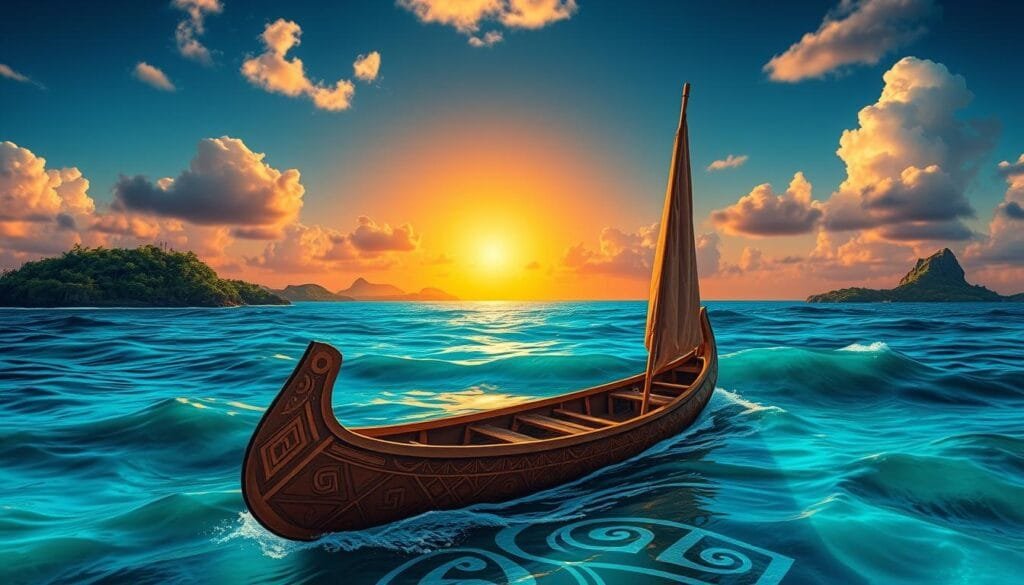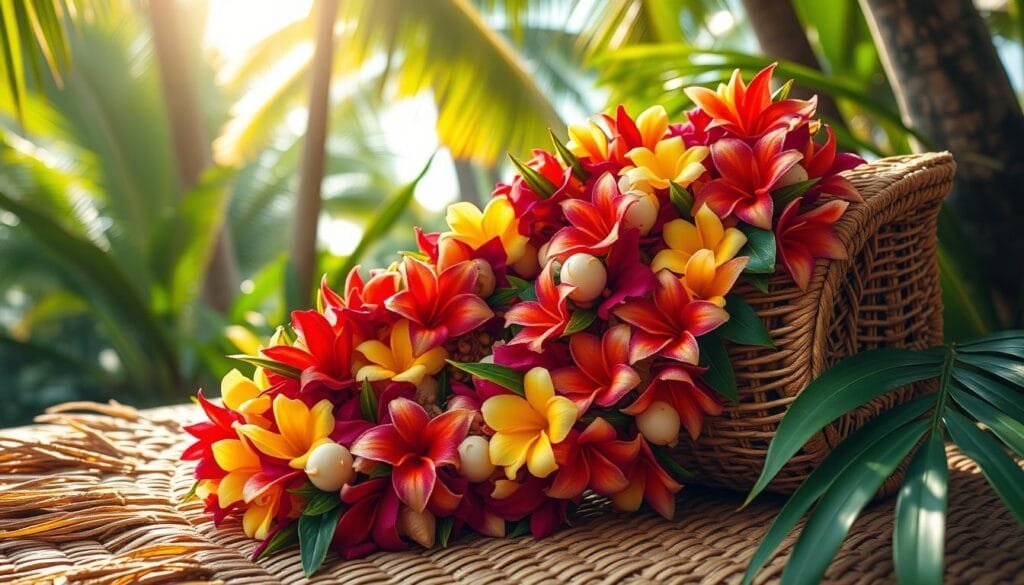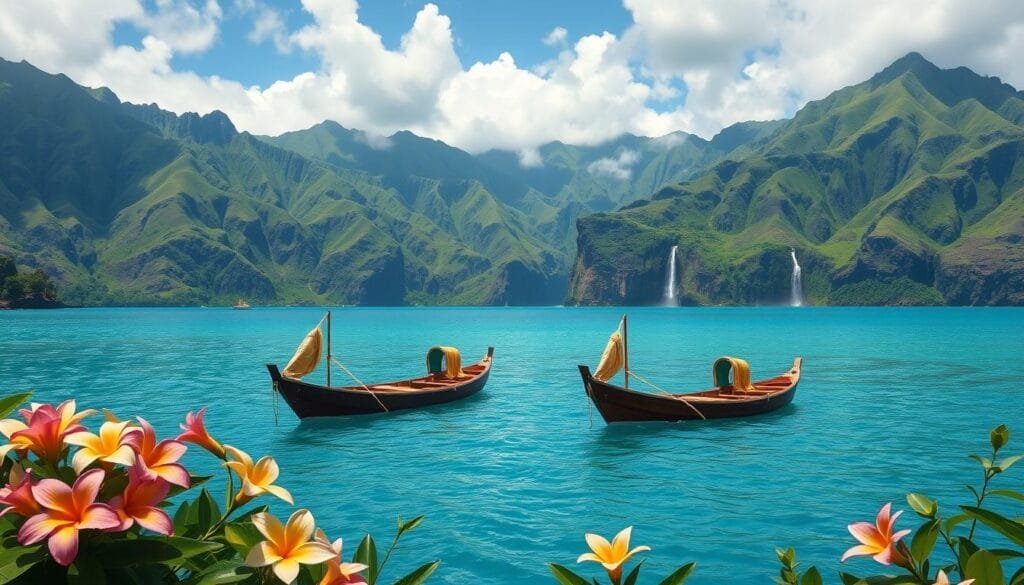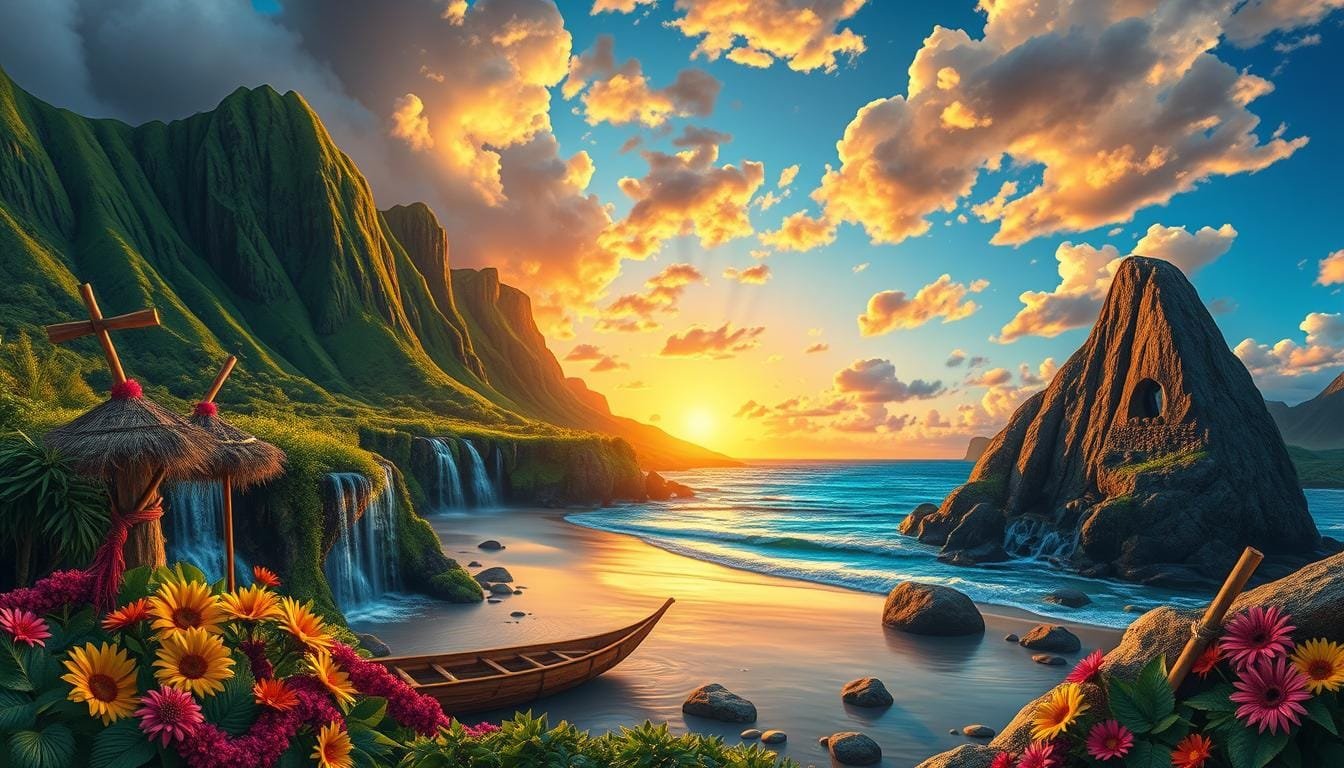What makes a group of islands in the Pacific so culturally rich? Hawaiian culture is filled with values like connection, respect, and togetherness. These values have captured hearts worldwide. Its history includes the art of lei-making and hula. These traditions make Hawaiian heritage key to cultural preservation.
The journey of Hawaii’s early people covered over 2,000 miles of ocean. They built a society with a strong social order. Today, these traditions keep the community strong and connect people to their past. Let’s dive into how Hawaii keeps its culture alive and how it influences people everywhere.
Key Takeaways
- The estimated first settlements of the Hawaiian islands occurred between 400 and 1100 CE, with new findings suggesting a timeframe of 1219 to 1266 CE.
- The Polynesian colonization of Hawaii happened in two major waves, including a significant pulse between 1190 and 1290 CE.
- Archaeological sites such as the Waiʻahukini Rockshelter and the Hālawa Dune Site provide insights into the daily life and usage of land by early Hawaiians.
- Prior to European contact, Hawaii had a large population, sustained by advanced aquaculture practices including fishponds producing millions of pounds of fish annually.
- Initial Hawaiian settlements likely started on the Big Island’s southern coast and expanded northwards.
The Deep-rooted Values of Hawaiian Culture
Hawaiian culture is closely tied to family, kindness, and caring for the environment. It shows us how communities can flourish. The island’s traditions highlight the importance of ‘Ohana, the Aloha spirit, and living in harmony with nature. This reflects a deep bond with people and the land.
‘Ohana: The Concept of Family
The idea of ‘Ohana includes not just immediate family but also friends and the larger community. It embraces inclusivity and unity. This view of family creates a strong support network. It goes beyond traditional family lines.
Aloha Spirit: The Essence of Kindness
The Aloha spirit is a key part of life in Hawaii. It promotes respect, kindness, and compassion. This approach strengthens bonds between people. It builds a unified and peaceful community. The Aloha spirit encourages Hawaiians to care deeply for each other.
Respect and Harmony with Nature
Respecting the environment is vital in Hawaiian culture. It comes from believing everything in life is connected. Hawaiians honor and protect their natural resources. This shows the deep connection between the land and its people. Practices like recognizing ‘aumākua emphasize a give-and-take relationship with nature. They show a lasting dedication to looking after the environment and promoting sustainability.
How Long Has the Hawaiian Culture Been Around?
The roots of Hawaiian culture reach back to ancient Hawaii. The first settlers came from the Marquesas Islands around 400 C.E. This was an amazing trip of about 2,000 miles. This journey was a key part of Polynesian history, which started around 3,000 years ago. The Lapita people were the first to move to eastern Polynesia around 1000 B.C.E.

When Polynesians settled in Hawaii, they brought their traditions with them. These traditions define Hawaiian culture today. Some evidence points out that Native Hawaiians kept their culture alive for thousands of years. Then, Captain James Cook arrived in 1778. This led to big changes and finally, the U.S. took over Hawaii in 1898 illegally. These events changed and often suppressed ancient Hawaiian traditions.
The legacy of ancient Hawaii is strong, from water rights systems to storytelling. Documents talk about many journeys by Hawaiian ali‘i. These leaders had many wives or husbands. Religion was a big part of daily life in ancient Hawaii. There were four main gods and many lesser deities.
| Event/Period | Details |
|---|---|
| First Settlers | Marquesas Islands, 400 C.E., ~2,000 miles journey |
| Polynesian Migration | Lapita people to eastern Polynesia, 1000 B.C.E. |
| European Contact | Captain James Cook’s arrival, 1778 |
| Annexation of Hawaii | U.S. illegal annexation, 1898 |
| Hawaiian Cultural Renaissance | Revival in the 1970s |
The 1970s saw a rebirth of Hawaiian culture. This movement helped bring back native traditions. It also made sure Hawaiian culture played a big role in the islands’ identity. The Office of Hawaiian Affairs works to grow love for these traditions. They want to mix Polynesian history lessons into modern Hawaiian society.
Symbolism in Hawaiian Traditions
Hawaiian culture is deep with symbols that show its core values and traditions. The lei and hula are two famous symbols. They carry deep meanings and share the story of Hawaii’s history and its people.
The Significance of the Lei
The significance of the Hawaiian Lei goes beyond its beauty. It represents love, respect, and connection. These are often given at major life events like births, weddings, and funerals. This shows the aloha spirit.
In the past, leis like the lei hulu, made from bird feathers, were for royalty. This showed their social status. The art of making leis has grown to include techniques like Hilo, Kui, and Wili. Each technique has its own cultural meaning.
Lei Day is celebrated on May 1st every year. It honors the lei tradition. Although tourism in the 20th century commercialized it, Native Hawaiians kept its true cultural meaning. They see leis as symbols of deeper spiritual bonds.

The Role of Hula in Storytelling
The history of Hula is more than just entertainment. It’s an art form that combines sacred rituals with storytelling. Hula helps to keep stories of gods, heroes, and ancestors alive. Dancers train hard to master the movements and chants needed for true hula.
Hula is done in both private and public settings. It has deep roots in Polynesian symbols and Hawaiian myths. The Hawaiian Renaissance in the 1970s helped to bring back this art form. It showed its importance in keeping culture alive.
Traditions like these can also be seen at places like Papahānaumokuākea. This site shares the long-lasting cultural legacy of the Hawaiian Islands.
Cultural Practices That Celebrate Connection
In Hawaii, cultural celebrations are based on traditions that bring people together. These practices help to bond the community while preserving the islands’ rich heritage. They connect families and friends, strengthening a society that respects its past and embraces its future.
Lei-Making as an Act of Love and Gratitude
Making leis is a key part of Hawaii’s cultural events. These fresh leis are made from flowers and leaves. They are not just decorations; they represent friendship, the Aloha spirit, and love. They are given during special times like graduations, weddings, and anniversaries to show feelings that words cannot.
Hula Dancing as a Celebration of Life
Hula dancing is crucial for bringing people together in Hawaii. The traditional hula, Kahiko, includes chanting and tells stories through movement. It celebrates life’s big moments from birth to the passing of time. Hula lets people explore feelings of joy, sorrow, and more through dance.
Community Potlucks and Acts of Kindness
Community potlucks in Hawaii show the value of ‘Ohana, or family. These events allow people to share food, stories, and friendship. They showcase Hawaii’s diverse culture, mixing dishes from all over the world. You’ll find traditional Hawaiian foods as well as dishes from Japanese, Filipino, Chinese, and Portuguese influences.
| Activity | Symbolism | Occasions |
|---|---|---|
| Lei-Making | Love, Gratitude, Friendship | Graduations, Weddings, Anniversaries |
| Hula Dancing | Storytelling, Celebration of Life | Kamehameha Day, Cultural Festivals |
| Community Potlucks | ‘Ohana, Unity, Sharing | Neighborhood Gatherings, Birthday Celebrations, and Holidays |
Activities like lei-making, hula dancing, and community potlucks strengthen connections in Hawaii. They keep the Aloha spirit alive for all people, across generations.
Exploring Kauai: A Gateway to Polynesian Heritage
Kauai shows us the beauty of Polynesian culture and Hawaii’s history. It’s located at 22°04′12″N 159°29′51″W and offers a look into Kauai’s cultural heritage. Being the fourth largest island in Hawaii, it spans 562.3 square miles. This island takes us deep into the Polynesian legacy.

Visit the Kauai Museum to learn about Polynesian explorers who arrived around 600 C.E. and again around 1100 C.E. Here, ancient traditions such as lei-making and hula dancing show a profound connection with our ancestors and nature.
The Allerton National Tropical Botanical Garden is a must-see for its beauty and cultural stories. The Koloa Heritage Trail takes you on a scenic walk through Hawaii’s history. These experiences help us deeply connect with Kauai’s cultural heritage.
The Smith Family Garden Luau and Luau Kalamaku are top Polynesian cultural experiences. They bring Kauai’s traditions to life with music, dance, and food. These events help us appreciate Kauai’s vibrant history.
Explore more about these incredible cultural experiences to discover Kauai’s heritage further. Trying ukulele lessons or learning the Hawaiian language can deepen your connection with the local community.
| Attributes | Kauai |
|---|---|
| Highest elevation | 5,243 ft (1,598.1 m) at Kawaikini |
| Population | 73,298 (as of 2020) |
| Population density | 118/sq mi (45.6/km²) |
| Distance from Oʻahu | 73 miles (117 km) |
| Average annual rainfall on Mount Waiʻaleʻale | 460 inches (38.3 ft; 11.7 m) |
| Duration of the sugarcane industry | 1830s to 2008 |
By preserving Kauai’s cultural heritage, we honor our ancestors and celebrate the island’s unique role in Hawaii’s history. The stories of this island give us valuable insights into a world where tradition and modernity blend seamlessly.
The Ocean’s Importance in Hawaiian Culture
Hawaiians hold the ocean in high regard. It’s more than a natural resource; it’s part of their identity. Their legends and conservation work show this deep respect.
The Legend of Maui and the Manaiakalani
In Hawaiian mythology, the Maui demigod Hawaii is key to creating the islands. He used his magical fish hook, Manaiakalani, to pull the islands from the ocean. This story highlights the ocean’s sacred and life-giving role in Hawaiian culture.
This legend not only speaks of the islands’ mythic origins but also of the ocean’s endless potential and mystery. It influences the island’s environmental care today.
Commitment to Ocean Preservation
Our connection with the sea leads to real efforts to conserve marine life. This includes community projects and scientific work. For example, the Polynesian Voyaging Society works to keep traditional navigation alive. This shows our commitment to the ocean.
Our cultural bond with the sea inspires us to support sustainable practices. Hawaii takes action, like beach clean-ups and reef-safe rules, to protect marine life for the future.
- Community Education Programs
- Marine Protected Areas
- Promotion of Sustainable Fishing
- Scientific Research and Monitoring
| Initiative | Description |
|---|---|
| Community Education Programs | Teaching locals about marine conservation in Hawaii. |
| Marine Protected Areas | Setting aside ocean areas to safeguard marine life and habitats. |
| Promotion of Sustainable Fishing | Supporting fishing practices that protect the ocean’s future. |
| Scientific Research and Monitoring | Studying the ocean to guide conservation efforts. |
By supporting these efforts, we honor our heritage and the nurturing ocean. We aim to keep the Maui demigod Hawaii legend and our waters’ rich life thriving.
Preserving Hawaiian Culture Through Education
Keeping Hawaiian culture alive is closely linked with teaching about it. Hawaii’s public education system started in 1840. It’s the oldest one west of the Mississippi. Originally, Hawaiian was the language used in schools. But in 1896, it got banned. This led to the Hawaiian language vanishing from education for generations. Yet, efforts to keep the Hawaiian language alive have been key to bringing back this special part of the culture.
In the late 1960s and early 1970s, people began to feel more proud of their Hawaiian roots. This feeling grew stronger in 1978. That year, Hawaii’s Constitution was changed to support teaching Hawaiian culture, history, and language in schools. This change led to the creation of the Hawaiian Studies Program (HSP) in 1980. The program made sure Hawaiian heritage was part of the curriculum for all ages.
The Hawaiian Language Immersion Program (HLIP) started in 1986. It helped teach classes in Hawaiian and promote the language. By the year 2000, Hawaii’s Education Office created new positions to support Hawaiian education. This included three HLIP Resource Teachers. By 2015, the Office of Hawaiian Education was set up to focus on Hawaiian studies in schools.
Education policies 2104 and 2105 look after Hawaiian education programs. They have changed several times between 2006 and 2014. These changes show Hawaii’s strong commitment to its unique culture. Through detailed programs, we hope to keep the Hawaiian spirit alive for the next generations.
Conclusion
Hawaiian culture has deep roots that date back to 900 AD and even earlier. It shows us a rich heritage that is very important to keep. We have seen how deep values continue to shape today’s community. From King Kamehameha’s formation of the Kingdom of Hawaii in 1795 to the efforts to keep traditions alive, these practices are truly significant.
Understanding the benefits of cultural preservation helps us see its key role. It gives the Hawaiian community a sense of identity and continuity. Keeping the Aloha Spirit, ‘Ohana, and respect for nature alive matters a lot. Education efforts also help share this knowledge with the next generation, making these values a part of everyday life.
Reflecting on Hawaiian community values reveals the importance of preserving this cultural legacy. It’s not just about keeping traditions alive but celebrating life itself. By valuing these traditions and principles, we help create a future that respects the rich heritage of the Hawaiian Islands.
FAQ
What elements define Hawaiian traditions and heritage?
Hawaiian culture shines through lei-making and hula dancing. The ‘Ohana’ concept and Aloha spirit are core values. They deepen community ties and show respect for nature.
What does ‘Ohana mean in Hawaiian culture?
‘Ohana in Hawaii means more than family. It includes friends and the wider community. This idea promotes unity and closeness beyond just family ties.
How does the Aloha spirit influence daily life in Hawaii?
Living with the Aloha spirit means being kind and respectful. It shapes how people interact, fostering a positive and united way of life.
How do Hawaiians demonstrate respect and harmony with nature?
Respect for nature in Hawaii comes through sustainable living and conservation. Cultural rituals also play a part, celebrating the land and sea.
What is the history of Hawaiian culture?
Hawaiian culture dates back about 1500 years to the first Polynesians. Their traditions and lifestyle have evolved, still shaping Hawaii today.
What is the significance of the lei in Hawaiian culture?
In Hawaii, the lei is a sign of affection, respect, and welcome. It’s given during special times to show gratitude and friendship.
How is hula more than just a dance?
Hula is a powerful way to tell stories. It brings to life tales of gods and ancestors through dance and chant.
How do cultural practices like lei-making and hula bond the community?
Lei-making and hula express emotions like love and joy. Shared during gatherings, they strengthen community bonds.
What makes community potlucks significant in Hawaiian culture?
Potlucks are key to the ‘Ohana spirit in Hawaii. They bring everyone together, sharing food and tales. It’s a reflection of Hawaiian generosity.
Why is Kauai important in preserving Polynesian heritage?
Kauai holds deep cultural and historical importance. It helps keep Polynesian heritage alive through traditions and festivals. Kauai acts as a gateway to Hawaiian history.
What role does the ocean play in Hawaiian culture?
The ocean is at the heart of Hawaiian life, inspired by myths like Maui. Efforts in marine care show the ocean’s importance to Hawaiians.
How are educational initiatives helping preserve Hawaiian culture?
Educational programs are vital for keeping Hawaiian culture alive. They focus on the Hawaiian language and cultural teachings. This ensures traditions continue for the next generations.
